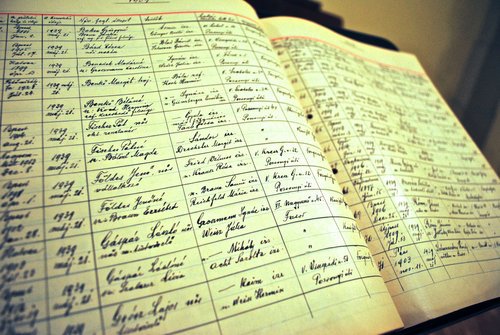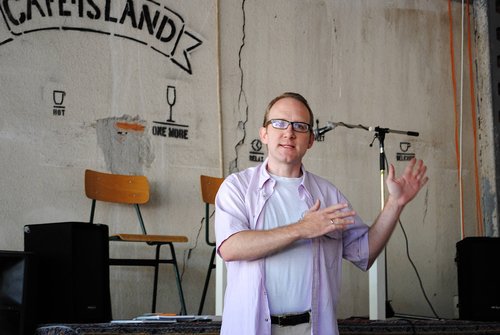The RCH and the Church of Scotland have a longstanding relationship and unique history. The following article is an interview with Rev. Aaron Stevens, current minister of St. Columba's Church of Scotland, discussing the evolution of the Scottish Mission in Budapest and the ties that bind both churches together.
Rev. Aaron Stevens, the minister of St. Columba's Church of Scotland, and I sit in his office on the upper floor of his church building, which in reality is an offshoot of the Vörösmarty School built by the Scottish Mission in 1910. He is digging around in the recesses of his bookshelf to find an old book that will aid him in the telling of his church's history. Finally, he pulls out a large blue book with a worn, cracked binding and yellowed pages. It is a baptismal registry with what appears to be a handwritten entry for every baptism the church has performed since 1843.
He points out some of the later entries where there is a column that indicates the member's church. "Baross tér, Baross tér, Fasor, Kálvin tér" he says going down the list. I of course, see nothing interesting in this revelation, but he continues and explains how odd it is to see that baptisms were regularly conducted in this church even though ministers recorded that those being baptized would, according to their address, belong in another parish. The reason being that this place was where Jews would come to be baptized – that the Scottish Mission was a place with a history of tolerance and cooperation. After being baptized here, they would go on to active membership elsewhere, in a Reformed church within their own neighborhood. "I think it's the only church around that has information like this in its records," he stated.
And this is the way our interview progresses. For every question asked, Aaron answers directly and then adds in a historical quip or anecdote. He throws out dates and names with ease, so when I ask him about the relationship between the RCH and the Church of Scotland, I know the answer will be if nothing else, thorough.

"It's historic," he says,"Both churches date back to the Reformation, so there was a connection well before anyone from the Church of Scotland came to Budapest." This relationship continued when Scottish missionaries came to Budapest in 1841 to establish a Mission with a main focus on evangelizing to Hungarian Jews. "One of their aims was to encourage Hungarian Protestants and work in cooperation with Hungarians," he explains. This Mission became know as the Scottish Mission, and later St. Columba's, in order to properly identify and separate itself as a church from the multitude of mission groups that flocked to Budapest after the fall of Communism.
Through the years, the mission of the Church of Scotland in Budapest has changed and evolved, but the relationship with the RCH has remained strong. "Ever since the Mission started, it has organically been a part of the Hungarian Reformed Church. It's their work and their project too."
There were two important times in the history of the Scottish Mission when Hungarians from the RCH led every facet of the Mission, after Scottish missionaries were temporarily expelled from Hungary and during the Communist era. There was even a time after the Scots were allowed back that they served beneath a Hungarian pastor. "Hungarian language mission was a part of the Scottish mission for the bulk of its history, and it was not too long ago that St. Columba's had both Hungarian and English language worship services every Sunday."

Rev. Stevens preaching at the Starpoint Reformed Youth Festival
"St. Columba's is a congregation of the Reformed Church in Hungary. This is an intentional statement that we are not here to be different, but instead, to be a part of the Reformed church here." So, I ask him what this relationship means to his congregation, and he answers me honestly, "Most of the members don't realize this connection and I doubt that they know how integrated we actually are."
It is not shocking, especially because St. Columba's current interaction with the RCH is mostly on a church governmental level. On the other hand, the congregation feels the connection between themselves and the country in which they live and serve. Aaron says the relationship with the RCH makes it less complicated for Hungarian members of St. Columba's. "It is easier for Hungarians that come to our church, because they don't have to leave their Hungarian Reformed roots. Hungarians make up the bulk of our members and I think it is a load off their mind, that even though the service is in English, it is still true to the way they were raised."
St. Columba's is a diverse group of Christians, and when I ask him to describe his congregation, he kind of smiles to himself as if he hears this question quite often. His answer comes as if read off a cue card, "Today, we are an international congregation worshipping in English in the Reformed tradition."
However, he follows this by being refreshingly frank. "Many of our members come not because they are Presbyterian or Reformed but because they don't speak Hungarian and are looking for an English-speaking, Protestant option, and many of the people in our congregation are on temporary assignments, so our congregation is always changing." International students, people working for multinational companies, language teachers, other volunteers and refugees make up a large, but transient portion of St. Columba's congregation.

He goes on to say that the fluidity of the church's members makes the church unique, calling it an "interesting ecumenical mix." Despite the instability in membership and the issues that arise from it, the mixture of nationalities does succeed in highlighting the legacy of the Scottish Mission as well as following the example left behind by its most well known missionary, Jane Haining.
The Scottish Mission built the Vörösmarty School as a safe place for young Jewish and Christian girls to live and learn together. Jane Haining came to Budapest as the matron of the school, overseeing the girls' day-to-day lives. When tensions began to rise before World War II, many people in Scotland urged her to leave Budapest and return home for her own safety. Haining refused and instead remained in the school with her students. Aaron quotes her, saying, "If the girls need me in the days of sunshine, how much more do they need me in the days of darkness?" Haining was arrested by the Arrow Cross party, taken from the school and ultimately sent to Auschwitz, where she was killed.
"Jane Haining was the example of tolerance before tolerance was cliché," Aaron says, "She was an authentic Christian witness among people of other faiths without forcing them to convert, and she showed great courage, because she didn't return home when she could have."
As he concludes, he ties everything back to St. Columba's present mission, "I think our work with refugees is a way of continuing her legacy - reaching out to others and loving them the same regardless of our differences." He continues by saying that the Scottish Mission, no matter which name it is operating under, has always had a recurring theme of refugee outreach, it has simply meant different things in different times.
"I'm not really comfortable saying that we 'reach out' to refugees, because they are members and a part of us," Aaron says, "It's not what we do; it's who we are. It's not just part of our outreach; it's our identity."
So, while through the years the Scottish Mission has evolved in name and mission, it really has not changed in the areas that matter most – the areas that define its identity.
You can find St. Columba's online here or contact Rev. Stevens by:
- Post: Vörösmarty utca 51 - Budapest 1064
- Telephone: +36 30 567 6356
Amy Lester